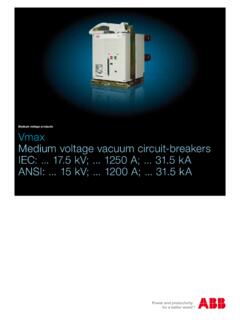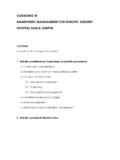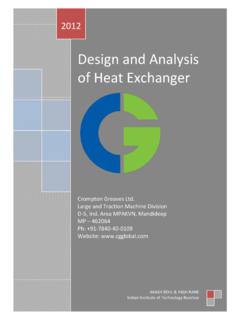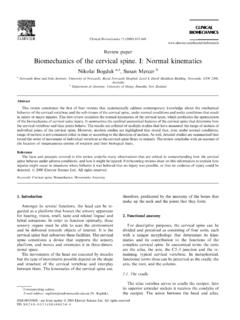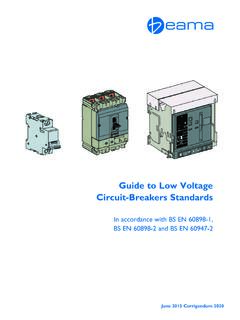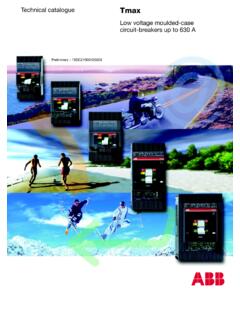Transcription of GUIDE TO CIRCUIT BREAKER STANDARDS - …
1 BS EN 60898: 1991BS EN 60947-2: 1996 GUIDE TO CIRCUITBREAKER STANDARDSThe Electrical Installation Equipment Manufacturers' AssociationThe Electrical Installation Equipment Manufacturers Association, is anautonomous, incorporated Association of British manufacturers of electricalinstallation equipment. The Association s roots date back to 1915 as a product section ofBEAMA The Federation of British Electrotechnical and Allied Manufacturers s Low Voltage CIRCUIT BREAKER Division consists of major UK manufacturingcompanies in this field and has its own officers, technical and other committees, alloperating under the guidance and authority of the EIEMA Board of Managementsupported by specialist central services for guidance on European Single Market,Quality Assurance, Legal and Health & Safety participation in the work of numerous national, international and regionalstandards committees has provided the background and support to ensure safety andperformance for the design.
2 Development and manufacture of its members result is quality equipment of the highest standard throughout each division of TO EIEMA AND IT S LOW VOLTAGE CIRCUIT BREAKERDIVISIONThis publication is available at plus postage and packing1 HarmonisationIn an ideal world, the compatibility of manufactured goods across a widegeographical area can remove barriers to trade and can result in an efficiency ofscale due to increased manufacturing volumes which in turn can reduce costs. In theelectrical industry, appropriate standardisation could mean common supply networksand products; and in low-voltage CIRCUIT BREAKER applications can result in: ability to use compatible equipment; no need to adapt or modify such products; fewer limitations on the source of this end considerable progress has already been made by the national standardscommittees of over 40 nations who are co-operating to formulate world standardswhich provide a consensus of international opinion on electrical supply StandardsParticipating countries comprise the International Electrotechnical Commission (IEC).
3 Most of these participating countries already have their own national standardswhich may differ from elements of the IEC STANDARDS . However when a need forharmonisation is identified, documents produced by the IEC may, where appropriate,form the basis for future national StandardsWithin Europe harmonisation of electrical products is controlled by CENELEC (ComiteEuropeenne de Normalisation Electrotechnique) which produces, appropriate Europeanstandards based on the work of the IEC once a need has been identified and is made up of the 18 national STANDARDS committees of the EC (EuropeanCommunity), and EFTA (European Free Trade Association). Whilst a EuropeanStandard can be a direct replica of an IEC standard, discussions within CENELEC mayresult in the formulation of a standard which includes commonly agreed types of European Standard exist: the European Norm (prefixed EN-) and theHarmonised Document (prefixed HD-) where EN- qualifies the adoption of thestandard by all member countries without deviation; and HD- qualifies that the standardhas been adopted subject to national general the first two numbers after the EN- or HD- prefix indicates the presenceor otherwise of an IEC Standard: 60 in the case of the former, 50 in the case of the Kingdom StandardsAdoption of the European Standard within the EC is mandatory.
4 In the UK suchstandards are further endorsed with the additional BS prefix, for example: BS EN 60898, the British Standard for CIRCUIT breakers for overcurrent protection forhousehold and similar VOLTAGECIRCUIT BREAKERSCHANGES INSTANDARDS2BS EN 60898 (EN 60898, IEC 60898)BS EN 60947-2(EN 60947-2, IEC 60947-2)Relates to Low Voltage CIRCUIT Breakers for use in household and similarinstallations. In the UK traditionally known as miniature CIRCUIT breakers(MCB s).Relates to Low Voltage CIRCUIT Breakers for use in industrial and similarinstallations. In the UK traditionally known as moulded case CIRCUIT breakers(MCCB s ) and also air CIRCUIT breakers (ACB s).The GUIDE also shows the timing for the introduction of the new standardsand withdrawal of existing 1 January 1997, all IEC publications have the number 60000 added to theold number, : IEC 898 has been renumbered as IEC 60898. For a period of timeduring the change over from one numbering system to the other, publications maycontain identities from both can be seen from the diagram above that up to 1987 no IEC Standard existed forminiature CIRCUIT breakers which, in the UK, have been manufactured since 1965 toBS 3871, under the title Miniature Air CIRCUIT Breakers for circuits.
5 The introduction in 1987 of IEC 898, under the title CIRCUIT Breakers forOvercurrent Protection for Household and Similar Installations , formed the basis foracceptance of the European Standard EN 60898; which was published in the UK in1991, as BS EN 60898. BS 3871 Part 1 was withdrawn on the 1st July are considerable differences between the BS 3871 and BS EN 60898 standardsand reference must be made to the STANDARDS for full of mention here and of interest to the specifier/installation designer are:Preferred Values of CurrentThe Imperial current ratings have been totally superseded by the Renard series whichhave been increased to include new values are 6, 10, 13, 16, 20, 25, 32, 40, 50, 63, 80, 100 and inclusion of 125A rated CIRCUIT breakers recognises the increasing cur:entdemand in final circuits and the requirement for suitable protection devices, compatiblein physical size with CIRCUIT breakers, and capable of being installed in the samestandard distribution VOLTAGECIRCUIT BREAKERSFOR USE IN HOUSE-HOLD AND SIMILARINSTALLATIONSBS EN 60898 (EN 60898, IEC 60898)Products which complied with BS3871 Part 1 before 1st July 1994, as shown by themanufacturer or by certification, were allowed to apply for production until 30th June this date all products must comply with BS EN 60898BS 3871 Part 11965BS EN 608981991EN 608981991 IEC 89819874 The Types I to 4 are omitted from the new standard which requires newinstantaneous tripping characteristics:There is no Type A instantaneous tripping characteristic to avoid confusion with the Aabbreviation for application of the new tripping characteristics should pose no problems tocircuit designers in that.
6 Type 1/Type Bare ideally suitable for domestic and commercial installationshaving little or no switching 2 and 3/Type Care best suited to general use in commercial/industrialinstallations where the use of fluorescent lighting, small motors etc. can be produceswitching surges which would operate a Type I / Type B CIRCUIT 3/Type Ccircuit breakers may be necessary in instances of highly inductivecircuits, for example, banks of fluorescent 4/Type Dare particularly suited to the protection of equipment such astransformers, some fluorescent lighting, X-Ray machines, industrial welding equipmentand similar applications where abnormally high inrush currents are 3871, BS EN 60898 TIME/CURRENTCHARACTERISTICSBS 3871 (OLD)Type to to to to EN 60898 (NEW)Type B3 to 5 InType C5 to 10 InType D10 to 20 InNote: IEC 898 permits the upper limit for type D to extend to 50 x = 32 AWhere In = rated current of the CIRCUIT breakerCurrent - (x In)Time (seconds)Type1 Type2 Type3 Type4 TypeBTypeCTypeD51020505BS 7671.
7 1992 Requirements for Electrical installations (16th Edition of the IEEW iring Regulations) specifically identifies Types 1, 2 & 3, Types B, C & D. Lower earthfault loop impedances (Zs) are generally necessary for Type 4 to achieve the operatingtimes required by Regulation 413-02-08. (Maximum Zs is calculated using the formulain the regulations and the characteristics of the CIRCUIT BREAKER ).Where the requirement cannot be achieved, use of CIRCUIT breakers as overcurrentprotective devices is not precluded, but the use of residual current devices (RCDs) toprovide protection against indirect earth fault conditions is of the value of the earth fault loop impedance (Zs) at the design stageof the installation will determine which type of CIRCUIT BREAKER should be 41B2 of the Wiring Regulations gives the same maximum loop impedancesfor Types 3 and C since their maximum instantaneous operating current coincides at 10times rated current.
8 The Table also quotes the same maximum values for either or 5 seconds disconnection BS EN 60898 the M category ratings for short- CIRCUIT capacities disappear. Themanufacturer must, however, declare the short- CIRCUIT capacity of the products atspecified power factors of test CIRCUIT . Higher short- CIRCUIT capacities up to 25kA arerecognised with the following values of Icn:I2tIIcn = 10kARATED SHORT-CIRCUITCAPACITY (Icn)BS EN 60898 (Icn)15001500A30003000A60006000A10000100 00A1500015000A2500025000 ANEW STANDARD TERMINOLOGY6BS EN 60898 UeRated Operational VoltageThe nominal voltage of the system should not exceed Single Pole Ue240/415 VThree Pole Ue= 415 VIn IEC Publication 38 the voltage values of 230v and 230/400v have been standardised. These values shouldprogressively replace the values of 240v, 220/380v and 240 Insulation VoltageThe voltage on which the dielectric properties are based using tests at high voltage andmains frequencyUnless otherwise stated the rated insulation voltage is the value of the maximum rated voltage of the circuitbreaker.
9 In no case shall the maximum rated voltage exceed the rated insulation CurrentThe current which the CIRCUIT BREAKER will carry continuously under specified conditionsand on which the time/current characteristics are otherwise stated Inis based on a reference ambient temperature of 30 In= 32A Trip Type C marked C32 .Ue = 240 VNBYRUe = 415 VUi = 500 VTested @2000V ac 50 HztIIn = 32 AUeUiIn7 IcnRated Short CIRCUIT CapacityThe calculated prospective fault current at the incoming terminals of thecircuit BREAKER should not exceed Icn= 10kA marked10000 Exception: Using back up protection as specified by the Short CIRCUIT Breaking Capacity[Not marked on the CIRCUIT BREAKER ]The maximum level of fault current operation after which further service isassured without loss of between service short- CIRCUIT capacity (Ics) and rated short-circuitcapacity (Icn) (factor k).NEW STANDARD TERMINOLOGYBS EN 60898I2tIIcn = 10kAI2tIIcs = 6000 A1> 6000 *> 10000 ** Minimum value of Ics: 6000 A** Minimum value of Ics: 7500 A8To fully understand the scope of IEC 60947-2, one must refer back to the origins ofcircuit BREAKER original standard in the UK was BS 3871 Part 2 1966, which was followed by theevolution of IEC 157 Part 1 1973.
10 This was incorporated as BS 4752 in the 1980 s the concept of the 947 series of STANDARDS evolved. This for thefirst time would bring all products relating to low voltage switchgear and control gearunder one generic standard. Refer to note on page 947 Specification for low voltage switchgear and control 947-1 General 947-2 CIRCUIT 947-3 Switches, disconnectors, switch disconnectors and fused combination 947-4 Contactors and motor 947-5-1 Control CIRCUIT devices - 947-5-2 Proximity 947-6 Multiple function switching 947-7 Ancillary 1989 the International standard for air CIRCUIT breakers IEC 157 was superseded byIEC 947-2. This was adopted as the European norm EN 60947-2 in March 1991. This waspublished in the UK as British Standard BS EN 60947-2 in May 1992 with thewithdrawal of the dual standard IEC 157/BS 4752 in September VOLTAGECIRCUIT BREAKERSFOR USE ININDUSTRIAL ANDSIMILARINSTALLATIONSBS EN 60947 -2 (EN 60947 -2, IEC 60947-2)Products which complied with the relevant national standard before 30thSeptember 1992, as shown by the manufacturer or by certification, were allowed toapply for production until September 1997.

